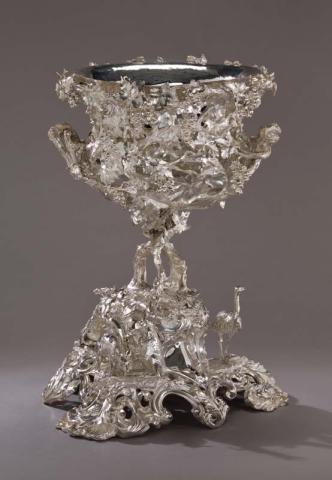HUNT & ROSKELL; Presentation vase
The magnificent Presentation vase 1864, made by the firm of Hunt and Roskell (1843–97) is the most important example of Victorian silver in the Queensland Art Gallery Collection. It has significant links with Australia in the beautifully cast and chased pair of kangaroos and an emu mounted on the base. The British firm was heir to the legendary Regency silversmith, Paul Storr, who established his business in 1819 as a partner; John Samuel Hunt married Storr’s niece. Hunt and Roskell’s peak reputation during the second and third quarters of the nineteenth century was recognised by the granting of a Royal Warrant.
The vase belongs to a group of similar major presentation pieces with openwork decoration in the form of interwoven vine branches, fruit and leaves and the mixture of naturalism and rococo-revival styles is very indicative of high Victorian taste in England. Naturalism, in the replication of the form and colour of the natural world, was a strong element in English decorative arts from the eighteenth century onwards. The English taste for the Louis XV style and the products of the Sèvres porcelain factory expanded at the end of the century with the wholesale dispersal of aristocratic collections after the French Revolution. The enthusiastic buyers in England developed a renewed interest in the earlier rococo style.
This ‘new’ rococo was one of the many design elements popular in nineteenth century England and by the middle of the century a fully blown rococo-revival style was underway in the decoration of furniture, porcelain and, especially, silverware. It is obvious in the elaborate and irregular scrolling of the base of this vase. This highly elaborate naturalistic decoration is unlike anything ever produced in the Australian colonies, though the presence Australian fauna (and a camel) around the base suggest that it was commissioned with an Australian connection in mind.
When Presentation vase was auctioned by Sotheby’s in New York on 26 April 1985 it was described as of ‘Australian interest’ as the catalogue entry stated that it was believed to have been a presentation to Charles Joseph Latrobe (1801–75) who was Lieutenant Governor of the Colony of Victoria from 1851 to 1854, before he returned to England. It was suggested that the date of 1864 celebrates the award of a government pension to Latrobe but, unfortunately, the identifying inscription has been removed. Removing inscriptions from presentation pieces was a common practice at that time, as it also removed any suggestion of financial difficulty for the owner.
However an additional identifying mark ‘Bredalbane 1876’ is linked by prominent silver researcher, Jolyon Warwick-James, to an inventory record for Gavin Campbell, (1851–1922), 7th Earl of Bredalbane who was one of the richest men in the British Isles. The Bredalbanes had a specific connection with Hunt and Roskell as the Frenchman, Antoine Vetche, worked for Hunt and Roskell when he produced the Bredalbane Vase-Caldlebarum which was one of the greatest attractions of London’s 1862 International Exhibition.
Latrobe’s substantial estate of £15 905 was largely derived from the sale of his property in Melbourne, so Presentation vase may have been resold to Hunt and Roskell by Latrobe’s widow at this time of financial need while Latrobe’s Melbourne executor completed his instructions. Although the Hunt and Roskell’s business records have not survived, the connection of Governor Latrobe with this item is consistent but must remain conjectural until further evidence is located.
Nevertheless the importance of an Australian connection cannot be doubted nor can there be a question to the importance of Presentation vase as an exemplar of high Victorian design and workmanship. It is a most worthy acquisition to celebrate the 30th anniversary of the Queensland Art Gallery Foundation.
Glenn Cooke, Artlines 3-2009, p.37.
Connected objects

Presentation vase 1864
- HUNT & ROSKELL - Creator